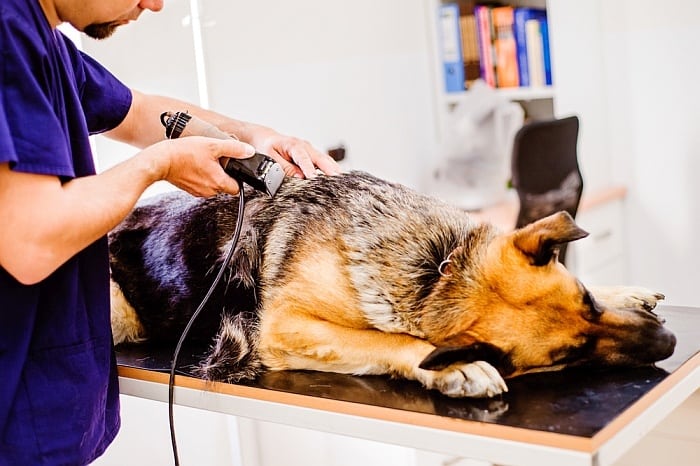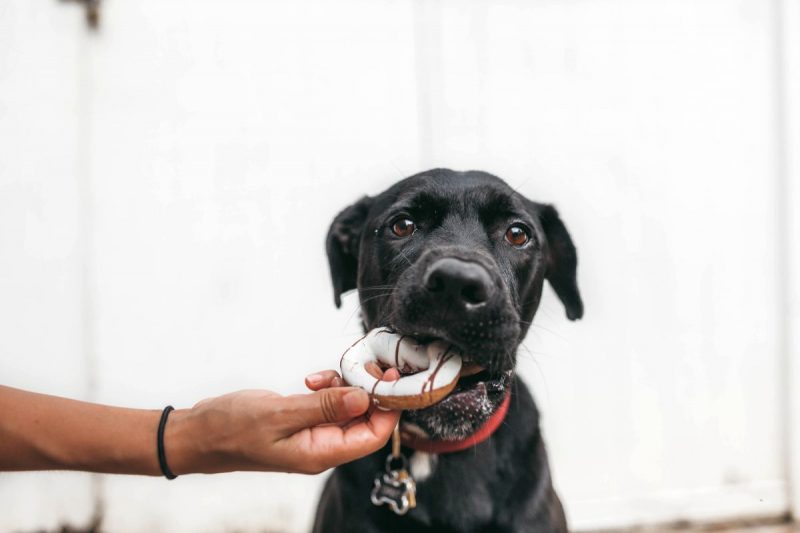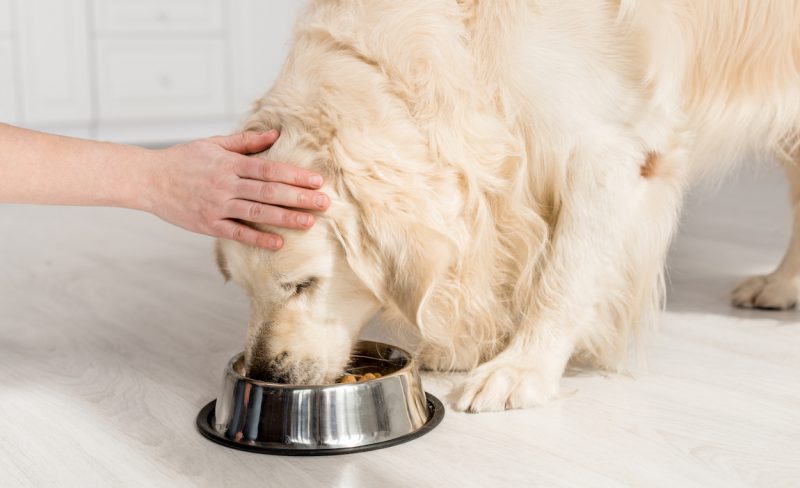Hot spots are a relatively common ailment that afflicts many dogs. But, while hot spots are a relatively minor health issue, they can make your dog absolutely miserable, so you’ll want to treat them as quickly as possible.
There are a variety of different ways to do so, and many owners have begun using coconut oil to treat their dog’s hot spots.
We’ll discuss hot spots and the use of coconut oil to treat them, as well as a few alternative hot-spot treatments below.
What Are Hot Spots?
The term “hot spot” refers to a condition that veterinarians call acute moist dermatitis.
Warm, damp and red, hot spots are usually surrounded by an area of hair loss, and they may exude pus or clear fluid. Sometimes, they appear crusty and they can grow remarkably quickly. Some may reach 5-inches in diameter over the course of mere hours.
But no matter how big or small they are, they are no fun for your floof.
Hot spots are caused by a combination of factors that are not entirely clear. They often occur following some type of wound, such as a flea bite, which causes your dog to begin biting and licking the area obsessively. This self-inflicted trauma irritates the skin and prevents it from healing.
However, bacteria also play an important role in the development of hot spots. The bacteria can be limited to the surface layers of the skin, or it can penetrate deeply into the skin layers and nearby hair follicles. Deeper bacterial involvement often causes “satellite” lesions to form, and more aggressive treatments are needed to treat such cases.
Traditional Treatment Regimen
The first thing you’ll need to do upon noticing your dog has an itchy, red spot is to visit your veterinarian.
While most cases are easy to treat, hot spots can occasionally prove resilient and recur time and time again. In either case, they are very distressing for your pooch, and you’ll want to help her heal as quickly as possible.
Your vet will begin by examining the area thoroughly. This may include shaving the surrounding area to help keep it clean and reveal the presence of any satellite lesions.
Hot spots are generally easy for vets to diagnose, but it can be difficult to determine the underlying cause of the problem. Skin scrapings may be collected to test for the presence of mites or other parasites.
Treating dog hot spots usually involves several different steps. The area must first be cleaned with gentle antiseptics to help dry out the wound, and then anti-inflammatory agents are administered to help stop your dog from itching. This will hopefully stop your dog from licking or biting the wound, which will allow it to heal.
Antibiotics (either topical or systemic) may be prescribed to help resolve any infections present (particularly if the bacteria present have penetrated deeply into your dog’s tissues). Finally, your vet will try to work with you to determine the original cause of the wound, so that recurrences can be avoided.
Your vet may administer flea-preventing medications if the little bloodsuckers are thought to be the cause. It may also be necessary to fit your dog with an e-collar to prevent her from accessing the wound.
Some of the most common things that allow bacteria to colonize your dog’s skin and cause hot spots include:
- Flea allergy
- Injuries
- Parasites
- Food allergies
- Contact dermatitis
- Anal sac disease
- The repeated licking of painful areas, such as those caused by arthritis
- Repetitive licking or biting due to boredom, stress, or anxiety
- Insect bites or stings
Note that dogs with thick coats or long fur are often more susceptible to hot spots than others are. Golden retrievers, for example, often suffer from hot spots, as do Saint Bernards, Rottweilers, Labrador retrievers and German shepherds.
It’s important to understand that antibiotics prescribed for hot spots may need to be administered for quite some time to be effective.
It isn’t uncommon for antibiotic courses to last two to four weeks in some cases.
Treating Your Dog’s Hot Spots with Coconut Oil
Some dog owners prefer treating hot spots with natural-sounding solutions, rather than the typical anti-inflammatory and antibiotic medications prescribed by vets.
You should always consult with your vet first before choosing to do so, but some owners have reported success following coconut-oil treatment regimens.
Owners typically treat hot spots with coconut oil by slathering a bit of the cream on their dog’s hot spot. It is usually reapplied as necessary, and when it works, the lesions will begin healing within a few days.
Coconut oil (in low quantities) does not represent an ingestion hazard, so you don’t need to worry about your dog licking it off – some owners even administer coconut oil orally in an effort to help improve digestive function.
Generally speaking, coconut oil appears safe and rarely causes side effects aside from gastrointestinal irritation (although pancreatitis has been linked to consumption of large quantities).
However, there are a few problems with using coconut oil to treat hot spots.
While coconut oil is thought to help moisturize a dog’s skin (it is also used by humans for similar purposes), but some vets dispute this contention.
Traditional hot spot treatment strategies seek to dry out the wound, rather than keep it moist. Hot spots, by their very nature, are already moist.
Coconut oil has constituent chemicals (lauric acid, in particular) that have been shown to exhibit some antibacterial properties. Lauric acid has been shown, for example, to kill Propionibacterium acnes (one of the bacteria responsible for human acne) in a test tube and Streptococcus mutans in living subjects.
Despite this, coconut oil is not the broad-spectrum agent that it is often characterized as.
There is a big difference in treating isolated bacterial strains and treating the broad range of bacteria present on your dog’s skin and hot spots. Your dog’s skin (like your own) is home to a menagerie of bacterial strains, which form a complex ecosystem.
Killing off a handful of bacteria may or may not be helpful in treating the condition. It is possible that you will kill off one of the bacterial species that is competing with the bacteria associated with your pet’s hot spot. This could theoretically worsen the condition.
In fact, very little research has been conducted on the use of coconut oil for pets – most of what is thought to be known has been extrapolated from research performed on humans.
One study demonstrated that coconut oil soap was effective home remedy for treating mange, but there is no clinical research showing that topical coconut oil application has any meaningful benefit in the treatment of hot spots.
The takeaway? Consult your vet before using coconut oil to treat your dog’s hot spots, but don’t be shocked when your vet recommends a traditional regimen of antibiotics and anti-inflammatory medications.

Alternative Hot Spot Treatments
There are a variety of other treatments some owners use to address their pet’s hot spots. While some may be effective for treating very mild cases, there isn’t any research to validate these approaches.
Again, it’s generally a better idea to visit your veterinarian and follow the course of treatment recommended.
Some of the most common alternative treatment strategies include:
- Placing a steeped and cooled tea bag against the afflicted area several times per day.
- The application of a variety of herbs and plant extracts. Each proponent seems to recommend different ones, and some even advocate using potentially harmful extracts, such as those derived from poison ivy.
- Giving your dog an oatmeal bath.
- Applying a vaporizing rub to the area.
Giving your dog an oatmeal bath probably won’t cause any problems, and the steeped tea bag treatment may not either, but be sure to use caution when attempting unproven treatment strategies to avoid visiting your vet.
Preventing Hot Spots on Your Dog
As with many other conditions, the best way to treat hot spots is to prevent them from occurring in the first place. And while it isn’t possible to completely eliminate the possibility that they will occur, you can take several steps to reduce the likelihood of them forming.
Some of the most helpful steps include:
- Keep your dog clean by bathing her on a regular and appropriate schedule.
- Be sure to dry your dog thoroughly after swimming or taking a bath – particularly during the warm and wet summer months, when hot spots are most common.
- Keep your dog’s hair brushed and properly groomed to avoid the development of tangles and matts, which can trap bacteria and irritate your dog’s skin.
- Use a preventative flea and tick treatment to keep your dog free of external parasites.
- Address any painful conditions from which your dog suffers promptly.
- Address any skin conditions, such as allergies or contact dermatitis, promptly.
- Ensure that your dog is sufficiently stimulated and receives enough exercise to prevent boredom- or stress-induced licking behaviors.
Additionally, it is imperative to treat hot spots as soon as possible to reduce the amount of irritation your dog experiences and to give your pup the best chance at a rapid recovery.
***
Has your dog ever suffered from hot spots? How did you go about treating it? Was it as effective as you had hoped? We’d love to hear about your experiences – including methods that worked and those that didn’t – in the comment section below!









Leave a Comment